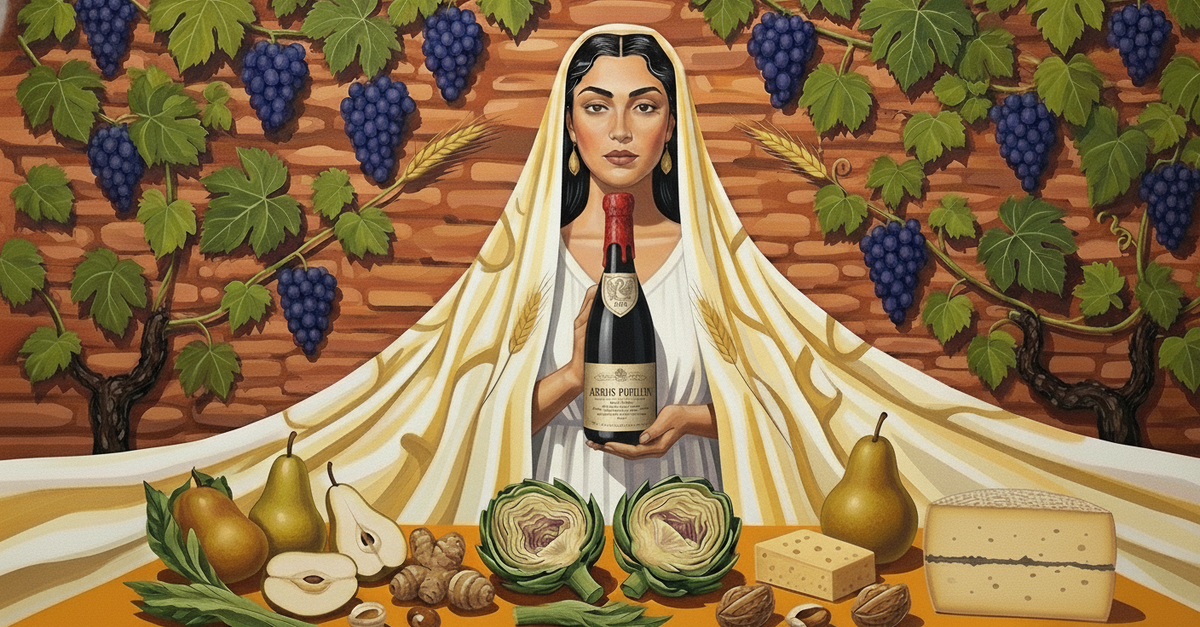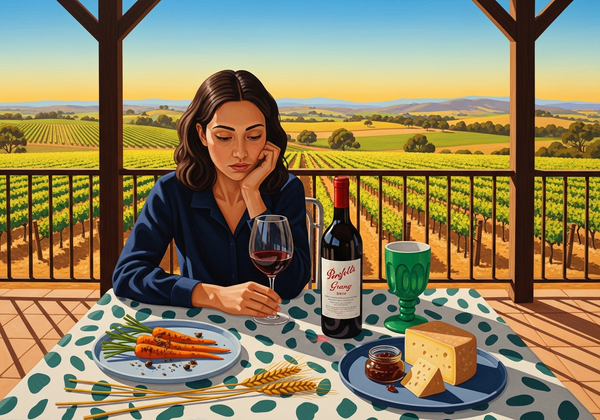Veins of Stone and Honey: Domaine Overnoy Arbois Pupillin 2018
A mythic take on Domaine Overnoy Arbois Pupillin 2018 food pairing—Savagnin with trout, salsify, Morbier, and echoes of limestone and lore.

The wine enters like a whisper through wet leaves—amber shot with light, the color of autumn honey seen through smoke. I pour it as the rain begins, letting the first swirl breathe for half an hour, a gentle unveiling rather than a command. At 14 °C, it stretches awake: Savagnin’s voice clear and saline, touched by the faintest ghost of walnut. I prefer it in a tulip glass, where air and memory meet at the rim. What rises is both orchard and cellar—baked pear, curry leaf, and the smell of rain-damp straw.
A Vineyard at the Edge of Reason
In the folds of the Jura, the village of Pupillin lies between forest and sky. Emmanuel Houillon tends Domaine Overnoy’s vines as one tends a prayer—without artifice, guided by trust in soil and time. His Savagnin, grown on marly limestone that fractures to reveal fossil shells, ripens slow under cool light. Fermentation moves by instinct, not clock, and the wine ages beneath a living veil of yeast—that thin, breathing skin the locals call voile. Here, oxidation is not decay but revelation.
The Soul Beneath the Flor
The 2018 vintage was sunlit yet poised, a year of generosity rather than heat. This Savagnin stands between worlds—not Vin Jaune, not ouillé, but something in-between, like a word spoken halfway between waking and dream. Its body is sinewy, dry as parchment yet pulsing with acid. Lemon oil, quince, chamomile, roasted hazelnut, and a flicker of green curry root thread through the palate. The finish lingers like incense: salt, spice, and quiet persistence. It is a wine that does not seduce but summons—the kind you hear before you understand.
I have known wines like this before, in older tongues. In Sumer, I was called Geštin-anna—the Heavenly Vine—scribe of the underworld and keeper of dreams. When I drink Overnoy’s Savagnin, I taste both duties in one mouthful: the sunlight that ferments into wisdom, the cellar air that remembers each vintage as scripture.
Of Earth and Salt: The Classic Pairing
Savagnin walks a narrow bridge between nut and acid, and so must its companions. Forget the tired tropes of cheese and poultry—seek what stirs both light and shadow.
Charred salsify in Vin Jaune butter is the first union—earthy root char giving smoke to match the wine’s oxidative murmur, while the butter, spiked with a spoon of the same Savagnin, folds salt and fat into its acidity. It is food that tastes of memory, the kind a vineyard worker might invent after a frost.
Then there is trout baked with sorrel and green walnut oil. The fish’s flesh echoes the wine’s clarity, and the tang of sorrel mirrors its cut. Walnut oil lends an aromatic bridge, a shimmer of oxidation to meet Savagnin halfway across its strange terrain.
When the Familiar Turns Wild
For a gentler path, I turn to Jerusalem artichoke velouté with roasted hazelnuts and pear ash. Its silken texture lets the wine’s acidity play like light on skin; the earthy sweetness of the artichoke harmonizes with the Savagnin’s nutmeg warmth. Or, for something humbler yet divine, buckwheat galettes with melted Morbier and pickled chanterelles—the smoke of the grain and the cheese’s creamy funk balancing the wine’s linear edge.
When I served this wine to a mortal poet once, he paired it with silence and a candle, and that too was fitting.
The Vegetarian Feast of Earth and Light
If you must summon meat, summon something as disciplined as this wine. Pheasant slow-braised with verjus and wild herbs carries both austerity and grace. The verjus, young and sour, rhymes with Savagnin’s acidity; thyme and juniper reach toward its forested core. Or for a colder season, veal sweetbreads with beurre noisette, preserved lemon, and alpine herbs, where the browned butter mirrors the wine’s hazelnut undertone, and the preserved citrus flicks brightness through its savory weave.
Each pairing, mortal or divine, is built on tension—acid against fat, salt against nut, purity against oxidation. I have learned across millennia that perfection lies in the balance of opposites. As in life, so in wine.
The Small Indulgences
When the table clears, leave one glass half-full. Let it sit as conversation wanes. You will notice the scent shift: from orchard to wax, from citrus to dust. This is Savagnin’s descent, its half-year underground. It does not fade; it transforms. I, who descend each season to the shadowed halls to record the names of the dead, understand this cycle well. The wine will survive there, deep and unhurried, until its resurrection in the glass.
Domaine Overnoy Arbois Pupillin 2018 asks for contemplation, not applause. It is vivid now but will gather grace until 2035, maybe beyond. To drink it is to taste the patience of stone, the sweetness of restraint.
“When the vine sleeps beneath the frost,” I whisper, “I too descend—but the dream of the grape endures.”





